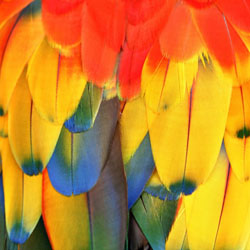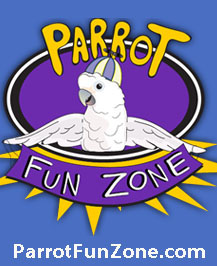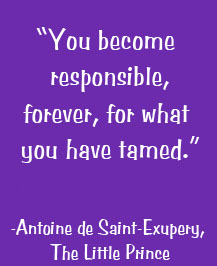 Feathers are unique to birds and they are an elegant masterpiece of design. The three most prevalent categories of feathers, each of which serves a distinct purpose, are the:
Feathers are unique to birds and they are an elegant masterpiece of design. The three most prevalent categories of feathers, each of which serves a distinct purpose, are the:
- Flight feathers which are located on the wing and tail are long, strong and flexible to provide power for flight.
- The wing feathers overlap to provide a surface to push against the air on the downstroke and create lift.
- The tail feathers are used for lift, balance, steering and braking.
- Contour or body feathers which provide for a bird's smooth shape and color. The contour feathers overlap each other like roof shingles to provide for protection to the skin from injury, the weather (wind & rain) and sunlight.
- Down feathers which are soft and fluffy and help to insulate birds by trapping air and preventing their skin form getting wet.
Feathers also serve to:
- assist some species to blend into the environment (camouflage)
- show off secondary sex characteristics
- allow for courtship display (tail-fanning)
Feathers are a key indicator of a bird's health status. A healthy bird will have shiny, brightly colored and smooth plumage. Conversely, an ill, stressed or malnourished bird's feathers often exhibit stress bars or are dull, discolored and rough in appearance. Poor feather condition, in many cases, is simply the result of poor hygiene and the lack of bathing opportunities.
Preening
Due to their importance, birds instinctually take each day to make sure their feathers are "all in order." Feathers must be kept clean, fluffed, oiled and neatened up daily through the process of preening.
Birds preen by methodically running their beaks through their feathers or by scratching their heads with their toes. Birds also rub their heads against objects in their cage to assist in reaching the hard to get spots. In the process, they are busily grooming and removing the feather shaft "wrappers" as new feathers come in, returning their feathers to their correct position and form, removing parasites and waterproofing and conditioning their feathers.
Most parrots, with the notable exceptions of amazons and some macaw species, have a preen gland at the base of their tail. This gland produces an oil that helps to keep the feathers and beak conditioned. During the preening process, parrots are observed "pinching" this area and then rubbing the area with their beak to "collect" the oil. The oil is then transferred to the other feathers as they are individually preened. The oil also contains vitamin D3 precursors that, upon exposure to sunlight (UV-B rays), are converted to the essential vitamin D3 which is then ingested during the preening process.
Moulting
A bird's feathers are replaced with new ones 1-2 times per year through the natural process of moulting. The frequency of moulting varies from species to species and the moulting process is staged so that a bird doesn't lose all of it's feathers at once, which would impair their ability to fly and regulate their body temperature.
You can tell a bird is moulting by the abundance of feathers floating around the floor and the appearance of pinfeathers. Pinfeathers on a bird's head or neck can be annoying to a bird. New feathers grow inside a sheath that needs to be broken open to allow the feather to expand. A singly caged bird may appreciate your help in preening the new feathers that he can't reach. You can open up the feather by carefully and gently squeezing the shaft with a finger nail or by rolling them between your fingers to break the sheath. Be careful to avoid blood feathers as squeezing them may cause your bird some discomfort. Blood feathers are new, developing feathers that still have a supply of blood running through the quill. Blood feathers can be identified by their thick dark shaft.
Moulting can be a stressful time for a bird and it is important to make sure they are provided a nutritious diet and plenty of rest. During a molt, your bird's body demands a higher level of energy and nutrients. Therefore, dietary supplements may be beneficial.
Making sure your bird has adequate opportunities for bathing will also help alleviate some of the itchiness factor for your bird.
Feather Picking
Feather picking is a destructive, often obsessive behavior in which a bird destroys its feathers by over-preening, biting them in half or pulling them out. This is one of the most frustrating and complex problems a bird owner may have to face. There are many possible causes of feather picking behavior and halting it is very difficult as there are no easy solutions to the problem.
There are medical and non-medical causes for feather picking. The first step to take if your bird starts feather picking is to have him examined as soon as possible by your avian vet to ensure the picking is not medically related (i.e., due to malnutrition, injury or illness). Common causes of picking are:
- Bacterial, viral or fungal infection
- Malnutrition
- Disease (metabolic, PBFD, PDD)
- Behavioral Origin (boredom, stress, anxiety)
- Allergies (mold, pollen, dust, food, mites)
- Environmental (low humidity, inadequate cage, lack of bathing opportunities)
- Exposure to toxins (zinc, indoor pollutants)
- Parasites (lice, Guardia)
- Physical pain (broken bone, internal organ)
If the picking is determined to be behaviorally or environmentally related you may want to consult with an avian behavioral consultant.
You can greatly reduce the chance of your bird starting this destructive behavior by consistently:
- Providing daily opportunities for bathing to encourage normal preening behavior.
- Providing a variety of stimulating toys to alleviate boredom including preening toys.
- Providing a nourishing and interesting diet
- Placing food and treats inside foraging devices
- Exposing your bird to natural sunlight or full spectrum light daily
- Allowing your bird to get adequate sleep
- Removing toxins from your bird's environment
- Interacting with your bird on a daily basis
- Reducing stressors in the environment.



















































































































































Comments powered by CComment